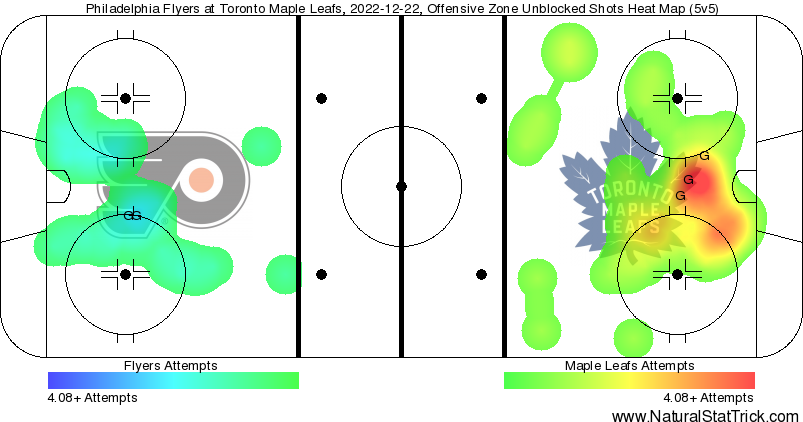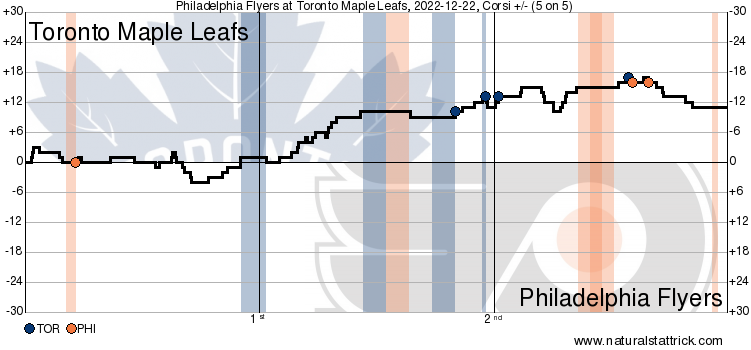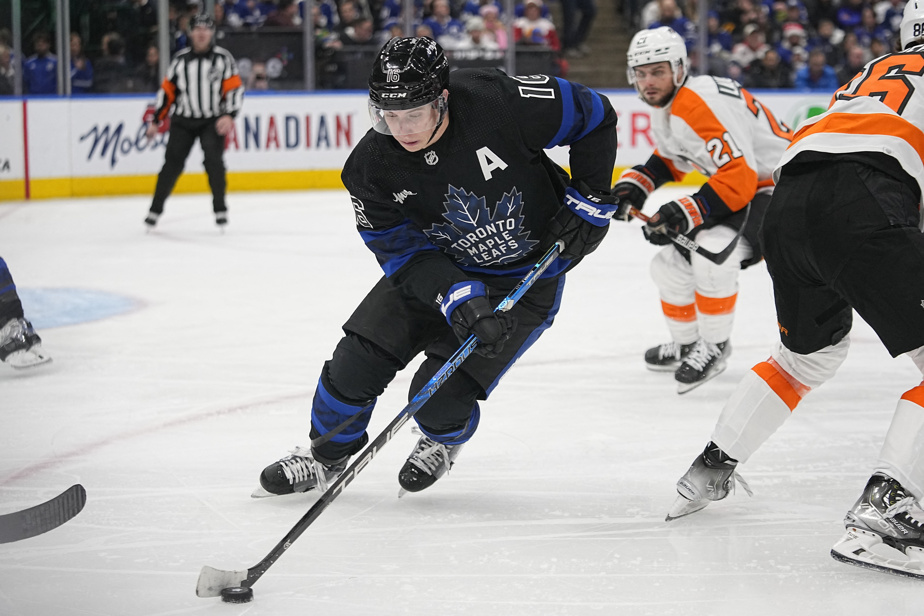Sheldon Keefe all but guaranteed a “funny game” in the final matchup before the break, and we certainly got one in this 4-3 win by the Maple Leafs (sloppy might be the more apt description).
Your game in 10:
1. On paper, a first period in which the Leafs outshot the Flyers 7-2 at five-on-five and attempted 12 shots to the Flyers’ 10 doesn’t look bad at all, but they were out-chanced 7-5 and the Flyers controlled the run of play for notable spells of the opening 20 minutes.
There wasn’t a ton of urgency in the Leafs‘ game compared to the Flyers’. In addition to the power-play goal against, they gave up a couple of two-on-ones in the period that Justin Holl negated (they basically didn’t concede any odd-man rushes the entire Tampa game).
On one of them, with Mark Giordano battling down low in the corner, the covering forward in William Nylander decided to push down the wall anyway to see if he could recover a puck. This came after Nylander reached in and took an early stick penalty leading to the Flyers’ 1-0 power-play goal.
We shouldn’t single out Nylander here, though (he would later score, pick up an assist, and draw a penalty leading to a goal). There were plenty of passengers in the first period, and a general going-through-the-motions vibe to the Leafs‘ play.
Whether it was the calibre of the opponent, the looming holiday break, the afternoon start, or some combination of it all, it was one of the Leafs‘ worst periods in a little while (all of this is said in relative terms based on the very high bar they’ve set for themselves).
2. The first big chance of the game went to the Leafs and Mitch Marner on a shorthanded breakaway, but he did not bear down on it. In fact, you could see him glance over his shoulder looking for the drop-pass-on-the-breakaway move he’s pulled off a couple of times leading to goals. In the end, it looked like he never really completed a deke or a shot on the play.
I was wondering if this was going to happen at some point. The drop-pass play looks amazing when the timing and circumstances are in place and it all clicks, but you better be extra sure if you’re thinking of passing backward on a breakaway, and your mind has to be focused on beating the goalie yourself when in alone, first and foremost.
The Flyers’ scored seconds later on their power play to make it 1-0, as is tradition in hockey when one glorious chance goes begging at the other end.
3. The first 10 minutes of the second period were a bit of a track meet; the Leafs conceded a breakaway to Nic Deslauriers coming out of the box in the first minute. Alex Kerfoot broke in alone for the Leafs a few minutes later (unsurprisingly, given his lack of finish this season, it was easily saved). There was quite a bit of activity happening at both ends, and there was also a spell of four-on-four during this stretch after a heated scrum around the Flyers net with Justin Holl and Jordie Benn in the middle of it for the Leafs, and (unsurprisingly) Travis Konecny front and center for the Flyers.
At this point, the Leafs weren’t playing terribly — and were getting their chances, of course — but they were playing down to the other team in terms of the game’s flow; it was a little leaky and loosely-played as opposed to the kind of systematic dismantling we’ve often seen from the Leafs with their airtight team game and structure over three zones.
4. In the second half of the second period, there was a huge spell of consecutive ice time — well over three minutes — for Mitch Marner and Auston Matthews coming off a really long delayed penalty sequence, a TV timeout, then a full two minutes on the ice on the PP.
On the power play, there was a lot of time spent on the perimeter sifting shots through from the point by Marner without success, but then one connected on a nice tip by Calle Järnkrok in the slot just after the power play expired to make it 1-0.
JÄRNY EVENS THINGS UP!! pic.twitter.com/x9RSZx79R4
— Toronto Maple Leafs (@MapleLeafs) December 22, 2022
Järnkrok is now up to five points in his last six games overlapping the injury. He had just six points in his first 21 games of the season as he was sort of mixed and matched all over the lineup, but he seems to be settling into the team (on a steady line with Tavares-Marner) and his season now even with the injury disruption.
5. At 1-1, the Leafs were now producing some of their best sequences of the game and looking more like themselves. The Alex Kerfoot – David Kampf – Pierre Engvall line, in particular, manufactured a dominant offensive-zone shift on the cycle — one of several from them in this game — where they ran the Flyers ragged for about a minute straight.
As a result of the third line’s efforts, the Flyers were scrambling to the bench for a change — a long change in the second period — and were scurrying back when William Nylander got partially in behind their defense and drew a penalty.
It was the second Leafs power play of the period that the third line created after Kerfoot drew a call pursuing a puck on the forecheck earlier on. This was the Leafs’ best line in the opening 40 minutes.
6. Just before the end of the second period, the Leafs scored almost immediately on the power play on another intended shot-for-tip attempt by Mitch Marner, only this one went straight through on net and seemed to take a strange bounce off of Carter Hart’s pad and in.
What goes better than Mitchy and Next Gen games???
We’ll wait… pic.twitter.com/KeS4Qr7Ola
— Toronto Maple Leafs (@MapleLeafs) December 22, 2022
Coming out for the start of the third, the Leafs scored what should’ve been a put-away goal to make it 3-1 inside the first minute. The top line worked a nice three-way passing play between William Nylander, Auston Matthews, and Michael Bunting from below the goal line, across the front of the net, and back into the slot as the Flyers weren’t ready to start the period and were switched off defensively. Bunting buried his fifth goal and 15th point in his last 13 games.
BIG MIKE!! pic.twitter.com/wZmS2W4rPc
— Toronto Maple Leafs (@MapleLeafs) December 22, 2022
The game wasn’t nearly done there, though.
7. The Leafs had turned it on and stormed back with a flurry of goals to take command of the game — as you were sort of expecting them to do at some point, frankly — and now it was about managing the game properly to the end. They certainly did not accomplish that, at least not in a remotely convincing manner.
At 3-1, a William Nylander turnover at the defensive blue line as Mark Giordano was jumping up into the breakout on the weak side led to a free-and-clear opportunity for the Flyers that Ilya Samsonov came up with a big save to deny.
Jordie Benn then took a bad penalty in the neutral zone, and the Flyers hit both posts on that power play before Giordano let a Flyer in behind him on a stretch-pass play, leading to another Leafs penalty (a big 5-on-3 kill followed there, including great work from David Kampf to clear and Mitch Marner to kill time with the puck).
There was also a play where Conor Timmins got beaten off the wall by Owen Tippett, who drove in on Samsonov (nice save there).
Maybe the Leafs wouldn’t have been this sloppy against a more serious opponent, but it was the calibre of game management that gets them burnt against good teams.
8. Even after William Nylander seemingly completely put the game away at 4-1 with his 20th (!) of the season, the Leafs continued to manage the game poorly by giving a goal straight back. With Conor Timmins deep in the offensive zone battling for a puck, the Flyers transitioned the other way, and despite having the numbers, the Leafs did not sort it out properly defending the rush.
Three Leafs converged on two Flyers on the left side, with both David Kampf and TJ Brodie committing to the puck carrier. Alex Kerfoot was beaten up the ice by Morgan Frost, who was in alone to finish off the 4-2 goal.
A minute and a half after the 4-2 goal, a lost neutral zone puck battle should not have been the end of the world for the Leafs, who had numbers back again, but they were undone too easily as Mark Giordano got beat on the play by Joel Farabee. Really, though, that was one Ilya Samsonov should’ve stopped along the ice.
It was now fully game on at 4-3.
9. It really could’ve been a full collapse by the Leafs in the third period.
At 4-3, Conor Timmins gave a puck away in the defensive zone for a chance at the side of the net that Ilya Samsonov stopped.
The most glorious chance was a missed wide-open net for the Flyers after a really tough shift from Jordie Benn, who missed the mark on a breakout pass, couldn’t settle a puck down along the d-zone wall, and then seemed over-eager to clean up the mess by chasing over onto Timothy Liljegren‘s side of the ice.
Mark Giordano was then guilty of a similar play where he left his post in the defensive zone over to his partner’s side of the ice and was bailed out by a big Samsonov save.
Even the chance to seal it with an empty net didn’t seem straightforward as David Kampf missed the empty net from the top of the crease. On another opportunity to put the game to bed with the net empty, the Leafs turned it over in the neutral zone, leading immediately to a Timothy Liljegren penalty and a Flyers power play.
A somewhat fortunate roughing call on Philadelphia in the final minute, negating the Flyers’ man advantage, bailed the Leafs out of a sticky situation of their own creation.
10. The Leafs have certainly earned enough benefit of the doubt to simply chalk this up to the pre-break afternoon-game silliness, take the two points, and move on without too much hand-wringing. The sloppiness with and without the puck, and the dodgy close-out effort in the third period, are the opposite of what have been their hallmarks of late.
Some of the individual struggles were uncharacteristic and easy to forgive. The Leafs’ defense core has been so consistent no matter who is in the lineup — tonight, it was Rasmus Sandin out due to an injury. A big part of the blue line’s success in spite of key absences comes thanks to Mark Giordano. Despite the assist on Nylander’s goal, Giordano played one of his worst games of the season; a creature of habit and a consistent morning-skate attendee even at age 39, you wonder if the routine change affected things as his timing and reads seemed off, which is out of character.
Jordie Benn was a little rusty at points, but it was his first game back after a layoff, and he gave the Leafs really good minutes earlier this season when they were in a pinch.
As for Conor Timmins, we are seeing some of the bad to along with the good now, which is not unsurprising. He is really short on NHL experience, and while he’s giving the Leafs good minutes overall with his puck-moving ability and nice offensive production so far, there is a reason why Kyle Dubas described his addition as helpful now but also a long-term play.
All in all, the Leafs will take the two points into the break and should rightfully feel quite good about the state of their game and the potential of what could lie ahead for them in 2023.
Heat Map: 5v5 Shot Attempts

Game Flow: 5v5 Shot Attempts





































